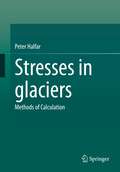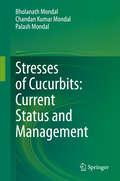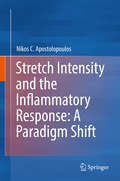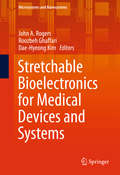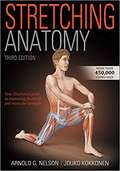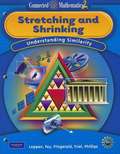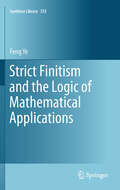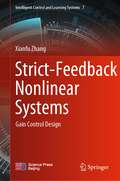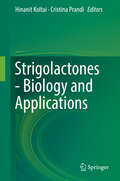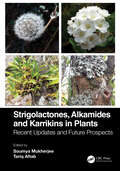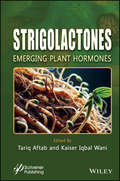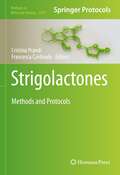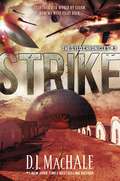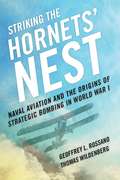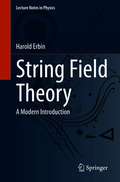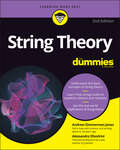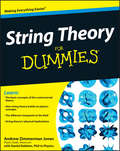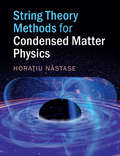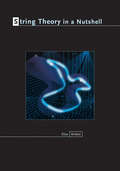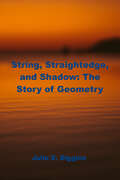- Table View
- List View
Stresses in glaciers: Methods of Calculation
by Peter HalfarIn this book, for the first time, a hitherto unknown general solution of the reliably known stress conditions is presented. This general solution forms a reliable and new starting point to get further in stress calculations than before. In this way, approximately realistic solutions can be found despite a recurring problem: the information deficits that are unavoidable due to the difficulty of exploring glaciers. This issue is demonstrated by the example of stagnating glaciers. For horizontally isotropic homogeneous tabular iceberg models, even mathematically exact unambiguous solutions of all relevant conditions are presented. All calculations use only elementary arithmetic operations, differentiations and integrations. The mathematical fundamentals are presented in detail and explained in many application examples. The integral operators specific to calculations of stresses facilitate the mathematical considerations. The stand-alone text allows the reader to understand what is involved even without considering the formulas. The author Peter Halfar is a theoretical physicist. He also developed a model of the movement of large ice caps (1983), which is still in use today.
Stresses of Cucurbits: Current Status and Management
by Bholanath Mondal Chandan Kumar Mondal Palash MondalWith advances in agro-technology, cucurbits are now being grown throughout the year. However, they are prone to biotic and abiotic stresses resulting in significant yield loss. Sustainable management of such stresses is a complex issue in the intensive cultivation of cucurbits involving high levels of fertilization and irrigation. Further, under the changing climatic conditions, pest scenarios vary constantly, with invasive alien species of pests becoming more common as a result of free trade and frequent international travel. As such, agrochemicals are being used as powerful weapons to combat the increasing number of pests and diseases. Lack of proper crop management technologies, inaccurate diagnosis, and indiscriminate and excessive use of pesticides are major causes of pesticide resistance and resurgence, environmental pollution, and hazards to the non-target biota. This comprehensive book provides essential insights into the management of biotic and abiotic stresses in cucurbit cultivation and re-evaluating the role of agrochemicals, and gathers information on insect pests, mites, nematodes, diseases and weeds, as well as on their sustainable management from scattered sources. Written in language that is easy to understand and including high-quality photographs, it is a valuable resource for students, researchers, plant protection specialists, extension workers, and growers.
Stretch Intensity and the Inflammatory Response: A Paradigm Shift
by Nikos C. ApostolopoulosIn this manuscript, practitioners and students who are concerned with sports and rehabilitation medicine, kinesiology, as well as coaches and athletes, are introduced to numerous concepts, including mechanotransduction, inflammation, pro- and anti-inflammatory cytokines, calpains, the extracellular matrix, neutrophils and macrophages, and their relevance to stretching, particularly stretching intensity. Although the quantitative parameters of training, duration, and frequency are important, it is the qualitative criterion of intensity (“how much”) that the author suggests is ultimately of greater concern. Intensity, the rate and magnitude of force, may be responsible for the proper recovery, regeneration, and adaptation of the musculoskeletal tissues from training, competition, or rehabilitation from injuries. Research suggests that too much force results in the stimulation of an inflammatory response, one associated with a biochemical feedback emerging from a mechanical stimulus. The intent of this manuscript is twofold: to initiate the discussion of the importance of stretching intensity with regard to proper recovery, regeneration, and adaptation, and to suggest that researchers need to explore its potential role in addressing numerous inflammatory (RA) and non-inflammatory (OA, recurrent tendinitis etc.) musculoskeletal conditions as well.
Stretchable Bioelectronics for Medical Devices and Systems
by John A. Rogers Roozbeh Ghaffari Dae-Hyeong KimThis book highlights recent advances in soft and stretchable biointegrated electronics. A renowned group of authors address key ideas in the materials, processes, mechanics, and devices of soft and stretchable electronics; the wearable electronics systems; and bioinspired and implantable biomedical electronics. Among the topics discussed are liquid metals, stretchable and flexible energy sources, skin-like devices, in vitro neural recording, and more. Special focus is given to recent advances in extremely soft and stretchable bio-inspired electronics with real-world clinical studies that validate the technology. Foundational theoretical and experimental aspects are also covered in relation to the design and application of these biointegrated electronics systems. This is an ideal book for researchers, engineers, and industry professionals involved in developing healthcare devices, medical tools and related instruments relevant to various clinical practices.
Stretching Anatomy
by Arnold G. Nelson Jouko KokkonenGet on the path to increased flexibility and improved muscular strength! With more than 450,000 copies sold worldwide, Stretching Anatomy, Third Edition, is your go-to guide for seeing inside the stretches that will help you increase range of motion, enhance recovery, and facilitate ease of movement during physical and everyday activities. <p><p> The visually stunning illustrations of 79 stretches cover all major joint areas of the body from the feet to the neck. Each stretch includes step-by-step instructions on how to perform the stretch, the names of the muscles stretched, and a Stretch Notes section detailing the procedures and benefits of every exercise as well as safety considerations and variations for increasing or decreasing difficulty. <p> You’ll find suggested stretching programs for daily mobility and flexibility, including stretches for people who sit or stand for extended periods, as well as a program proven to help lower blood glucose. Sport-specific stretching routines for 23 different sports are included for athletes and their trainers who want to improve flexibility, maximize efficiency of movement, and enhance recovery from training and competing in their chosen sport. <p> If tight hips, frozen shoulder, limited neck mobility, leg cramps, arthritis, or general muscle soreness are conditions you’re all too familiar with, use Stretching Anatomy, Third Edition, to develop a regular stretching routine that will help you move and feel better. <p> CE exam available! For certified professionals, a companion continuing education exam is available that can be completed after reading this book. The Stretching Anatomy, Third Edition Online CE Exam, may be purchased separately or as part of the Stretching Anatomy, Third Edition With CE Exam, package that includes both the book and the exam.
Stretching and Shrinking, Understanding Similarity
by Glenda Lappan James T. Fey William M. Fitzgerald Susan N. Friel Elizabeth Difanis PhillipsNIMAC-sourced textbook
Strict Finitism and the Logic of Mathematical Applications
by Feng YeThis book intends to show that radical naturalism (or physicalism), nominalism and strict finitism account for the applications of classical mathematics in current scientific theories. The applied mathematical theories developed in the book include the basics of calculus, metric space theory, complex analysis, Lebesgue integration, Hilbert spaces, and semi-Riemann geometry (sufficient for the applications in classical quantum mechanics and general relativity). The fact that so much applied mathematics can be developed within such a weak, strictly finitistic system, is surprising in itself. It also shows that the applications of those classical theories to the finite physical world can be translated into the applications of strict finitism, which demonstrates the applicability of those classical theories without assuming the literal truth of those theories or the reality of infinity. Both professional researchers and students of philosophy of mathematics will benefit greatly from reading this book.
Strict-Feedback Nonlinear Systems: Gain Control Design (Intelligent Control and Learning Systems #7)
by Xianfu ZhangThis book describes the research progress of the control design about strict-feedback nonlinear systems. A novel gain control design method is proposed, which greatly simplifies the construction procedure of controller for strict-feedback nonlinear systems. The control design problem of strict-feedback nonlinear systems is converted into the determination problem of gain parameters or the construction of dynamic gain equations. Therefore, the tedious iterative design procedure is effectively avoided. This book can be used as a reference for researchers in the field of control theory and engineers seeking advanced methods in practical control applications.
Strigolactones - Biology and Applications
by Hinanit Koltai Cristina PrandiThis book describes the exciting biology and chemistry of strigolactones. Outgrowth of shoot branches? Development of lateral roots? Interactions with beneficial microorganisms? Avoiding parasitic plants? Responding to drought conditions? These important “decisions” that plants make are all regulated by a group of hormones called strigolactones.The latest research has yielded a number of new biological concepts, such as a redefinition of plant hormones and their crosstalk, new functional diversity of receptors, hormonal “smoke and mirrors,” core signaling pathways, and even phloem transport of receptor proteins. Another important aspect of strigolactones is the related synthetic chemistry, which could pave the way for a variety of potential applications in agriculture and medicine.The book explains in detail the role that strigolactones play in plant development, and addresses the interaction of plants with soil biota and abiotic stress conditions, prospects of strigolactone biochemistry and evolution, and chemical synthesis of natural strigolactones and analogs, together with their potential applications. Including a glossary and end-of-chapter synopses to aid in comprehension, it offers a valuable asset for teachers, lecturers and (post-) graduate students in biology, agronomy and related areas..
Strigolactones, Alkamides and Karrikins in Plants: Recent Updates and Future Prospects
by Tariq Aftab Soumya MukherjeeStrigolactones, Alkamides and Karrikins in Plants: Recent Updates and Future Prospects providescomprehensive knowledge on the various aspects of plant growth, physiology, and communicationassociated with the three potential biomolecules. Strigolactones have gained much importance in thelast decade as potential plant growth regulators. Likewise, alkamides are also known for their plantgrowth regulatory and pharmacological properties. The evolutionary significance of karrikins as apotential signaling molecule in different plant groups has been fascinating to plant physiologists andecologists. This book enables the reader to gain insights into the myriad role of these biomoleculesin plant physiology in normal and challenging environments. The book offers comprehensive coverage of the most essential topics, including: • Regulation of strigolactone biosynthesis.• Strigolactones and plant stress tolerance.• Strigolactones and parasitic plants.• Alkamides and plant-microbe interaction in rhizosphere.• Pharmacological potential of alkamides.• Molecular associations of strigolactones and karrikins.• Karrikins in plant biotechnology.• Commercial realities of karrikins in biodiversity restoration. In reference to the recent findings in the field, the authors have provided insights into the role of eachbiomolecule and analyzed the future prospects of each cover area. The present book is the first of its kind, in which the three molecules have been integrated as potentialregulators of plant signaling, communication, and physiology in adverse conditions. Karrikins inplant biology is an emerging field in which its inter-relationship with strigolactones shall pave the wayto future investigations of the molecular mechanisms of plant stress tolerance, regulation of rootsystem architecture, and crop yield.
Strigolactones: Emerging Plant Hormones
by Tariq Aftab Kaiser Iqbal WaniThis book is a comprehensive guide to strigolactones’ role in plant biology, growth, and sustainable agriculture. Strigolactones, a fascinating and rapidly evolving class of plant hormones, have garnered significant attention in plant biology over the past decade. Initially discovered for stimulating the germination of parasitic plants, strigolactones are now recognized as key regulators of numerous plant processes, including growth, development, and response to environmental stresses. Their multifaceted nature and wide-ranging impact on plant physiology make strigolactones a critical study area for researchers aiming to enhance crop yield, resilience, and overall agricultural productivity. This edited volume provides a comprehensive overview of the current state of knowledge on strigolactones, exploring their biosynthesis, signaling mechanisms, and practical applications in agriculture. The book collects contributions from leading experts in the field, offering a diverse and in-depth perspective on the various roles that strigolactones play in plant biology. The chapters in this volume cover a broad spectrum of topics, from the molecular and genetic basis of strigolactone biosynthesis to their interactions with other phytohormones and environmental factors. The book examines the regulatory functions of strigolactones in plant architecture, including shoot branching, root development, and leaf senescence, as well as their involvement in stress responses such as drought, salinity, and pathogen attack. Also highlighted are recent advancements in understanding strigolactone signaling pathways and the potential for genetic engineering to manipulate these hormones for crop improvement. Audience Plant biologists, agronomists, horticulturists, and agriculture industry professionals studying plant development to address agricultural challenges.
Strigolactones: Methods and Protocols (Methods in Molecular Biology #2309)
by Cristina Prandi Francesca CardinaleThis volume presents the most useful laboratory protocols in strigolactones(SL) research. Chapters guide readers through wet-lab paths, issues around stability, protocols to evaluate SL activity, effects towards soil inhabitants such as parasitic plants, mycorrhizal and non-mycorrhizal fungi, nodulating bacteria, and protocols to assess effects on plant development are discussed. Written in the highly successful Methods in Molecular Biology series format, chapters include introductions to their respective topics, lists of the necessary materials and reagents, step-by-step, readily reproducible laboratory protocols, and tips on troubleshooting and avoiding known pitfalls. Authoritative and cutting-edge, Strigolactones: Methods and Protocols aims to deliver a clear-cut and standardized set of experimental protocols to a broad scientific community.
Strike: The SYLO Chronicles #3 (The SYLO Chronicles #3)
by D. J. MacHale#1 New York Times bestselling author D.J. MacHale is back with the third book in the SYLO Chronicles. Once again, Tucker Pierce and friends must fight for their lives against the better-equipped SYLO. All bets are off in Strike--with twists so big readers will never see them coming--while the action and pulse-pounding suspense remain as high as ever. Fans will be sure to devour this incredibly satisfying conclusion.Praise for the SYLO Chronicles: "A relentlessly fast-paced, intriguing, expertly-written tale that leaves you breathless and satisfied, yet wanting more. Highly recommended."--James Dashner, New York Times bestselling author of the Maze Runner series "Absolutely un-put-downable, more exciting than an Xbox and roller coaster combined."--Kirkus, starred review"If you're a fan of The Maze Runner and Alex Rider, you might want to pick up SYLO. . . . A fast-paced read and a huge cliffhanger."--EW.com"With this extremely high-octane story that's the equivalent to a summer movie blockbuster, MacHale kicks off an apocalyptic trilogy sure to leave readers demanding the next installment."--Booklist"This action-filled, end-of-the-world-as-we-know-it adventure . . . should leave teen readers clamoring for the next installment."--VOYA"An entertaining and creepy tale."--Publishers Weekly"MacHale pens some terrific and unique action scenes. . . will leave readers hungry for the next installment."--School Library Journal
Striking The Hornets' Nest: Naval Aviation And The Origins Of Strategic Bombing In World War I
by Thomas Wildenberg Geoffrey L. RossanoStriking the Hornets’ Nest provides the first extensive analysis of the Northern Bombing Group (NBG), the Navy’s most innovative aviation initiative of World War I and one of the world’s first dedicated strategic bombing programs. Very little has been written about the Navy’s aviation activities in World War I and even less on the NBG. Standard studies of strategic bombing tend to focus on developments in the Royal Air Force or the U. S. Army Air Service. This work concentrates on the origins of strategic bombing in World War I, and the influence this phenomenon had on the Navy’s future use of the airplane. The NBG program faced enormous logistical and personnel challenges. Demands for aircraft, facilities, and personnel were daunting, and shipping shortages added to the seemingly endless delays in implementing the program. Despite the impediments, the Navy (and Marine Corps) triumphed over organizational hurdles and established a series of bases and depots in northern France and southern England in the late summer and early fall of 1918. Ironically, by the time the Navy was ready to commence bombing missions, the German retreat had caused abandonment of the submarine bases the NBG had been created to attack. The men involved in this program were pioneers, overcoming major obstacles only to find they were no longer needed. Though the Navy rapidly abandoned its use of strategic bombing after World War I, their brief experimentation directed the future use of aircraft in other branches of the armed forces. It is no coincidence that Robert Lovett, the young Navy reserve officer who developed much of the NBG program in 1918, spent the entire period of World War II as Assistant Secretary of War for Air where he played a crucial role organizing and equipping the strategic bombing campaign unleashed against Germany and Japan. Rossano and Wildenberg have provided a definitive study of the NBG, a subject that has been overlooked for too long.
String Field Theory: A Modern Introduction (Lecture Notes in Physics #980)
by Harold ErbinThis textbook provides an introduction to string field theory (SFT). String theory is usually formulated in the worldsheet formalism, which describes a single string (first-quantization). While this approach is intuitive and could be pushed far due to the exceptional properties of two-dimensional theories, it becomes cumbersome for some questions or even fails at a more fundamental level. These motivations have led to the development of SFT, a description of string theory using the field theory formalism (second-quantization). As a field theory, SFT provides a rigorous and constructive formulation of string theory. The main focus of the book is the construction of the closed bosonic SFT. The accent is put on providing the reader with the foundations, conceptual understanding and intuition of what SFT is. After reading this book, the reader is able to study the applications from the literature. The book is organized in two parts. The first part reviews the notions of the worldsheet theory that are necessary to build SFT (worldsheet path integral, CFT and BRST quantization). The second part starts by introducing general concepts of SFT from the BRST quantization. Then, it introduces off-shell string amplitudes before providing a Feynman diagrams interpretation from which the building blocks of SFT are extracted. After constructing the closed SFT, the author outlines the proofs of several important properties such as background independence, unitarity and crossing symmetry. Finally, the generalization to the superstring is also discussed.
String Theory
by Joseph PolchinskiString Theory, first published in 1998, comprises two volumes which provide a comprehensive and pedagogic account of the subject. Volume 2 begins with an introduction to supersymmetric string theories and presents the important advances of recent years. The first three chapters introduce the type I, type II, and heterototic superstring theories and their interactions. The next two chapters present important recent discoveries about strongly coupled strings, beginning with a detailed treatment of D-branes and their dynamics, and covering string duality, M-theory, and black hole entropy. The final chapters are concerned with four-dimensional string theories, showing how some of the simplest string models connect with previous ideas for unifying the Standard Model. They collect many important results on world-sheet and spacetime symmetries. An appendix summarizes the necessary background on fermions and supersymmetry. An essential text and reference for graduate students and researchers interested in superstring theory.
String Theory For Dummies
by Andrew Zimmerman Jones Alessandro SfondriniUnravel the secrets of the universe and untangle cutting-edge physics Yes, you actually can understand quantum physics! String Theory For Dummies is a beginner’s guide, and we make it fun to find out about the all the recent trends and theories in physics, including the basics of string theory, with friendly explanations. Build a foundation of physics knowledge, understand the various string theories and the math behind them, and hear what the opponents to string theory have to say. It’s an exciting time to be alive in advanced physics, and this updated edition covers what’s new in the string world—the Large Hadron Collider, the Higgs Boson, gravitational waves, and lots of other big headlines. Unleash your inner armchair physicist with String Theory For Dummies. Brush up on the basics of physics and the approachable math needed to understand string theory Meet the scientists who discovered string theory and continue to make waves (and particles) in the physics world Understand what it’s all about with real-world examples and explanations Learn why string theory is called "The Theory of Everything"—and what it means for technology and the future Aspiring scientists or life-long learners will both be able to gain valuable information from this book. This accessible intro into string theory is for the theorists inside anyone.
String Theory For Dummies
by Daniel Robbins Andrew Zimmerman JonesLearn:The basic concepts of this controversial theoryHow string theory builds on physics conceptsThe different viewpoints in the fieldString theory's physical implicationsYour plain-English guide to this complex scientific theoryString theory is one of the most complicated sciences being explored today. Not to worry though! This informative guide clearly explains the basics of this hot topic, discusses the theory's hypotheses and predictions, and explores its curious implications. It also presents the critical viewpoints in opposition to string theory so you can draw your own conclusions.Understand the "theory of everything" -- grasp the key concepts and importance of the theory, and learn why scientists are so excited about finding a theory of quantum gravityIt all comes down to physics -- discover how string theory is built upon the major scientific developments of the early 20th centuryBuilding the theory -- trace the creation and development of string theory, discover its predictions, and see whether accurate conclusions can be madeTake string theory for a spin -- explore the core issue of extra dimensions, the implications for cosmology, and how string theory could explain certain properties of our universeBoldly go where no one has gone -- see what string theory has to say about possible parallel universes, the origin and fate of our universe, and the potential for time travelHear from the critics -- listen in on the heated debates about string theory and weigh the alternatives being offeredOpen the book and find:The questions string theory attempts to answerEasy-to-follow examplesExplanations of Einstein's theory of relativity, quantum theory, and particle physicsThe successes and failures of string theoryFascinating bits of string theory including strings and branesWays that string theory can be testedDiscussions of loop quantum gravity and other possible alternative theories of gravityHow the theory may relate to cosmic mysteries, from the origin of matter to black holes
String Theory Methods for Condensed Matter Physics
by Horaţiu NăstaseThe discovery of a duality between Anti-de Sitter spaces (AdS) and Conformal Field Theories (CFT) has led to major advances in our understanding of quantum field theory and quantum gravity. String theory methods and AdS/CFT correspondence maps provide new ways to think about difficult condensed matter problems. String theory methods based on the AdS/CFT correspondence allow us to transform problems so they have weak interactions and can be solved more easily. They can also help map problems to different descriptions, for instance mapping the description of a fluid using the Navier–Stokes equations to the description of an event horizon of a black hole using Einstein's equations. This textbook covers the applications of string theory methods and the mathematics of AdS/CFT to areas of condensed matter physics. Bridging the gap between string theory and condensed matter, this is a valuable textbook for students and researchers in both fields. The applications of string theory methods to condensed matter physics is a topical subject, and readers will gain understanding of both fields. No background knowledge is assumed so readers can come at the topic from different physics backgrounds. Gives an overview of most string theory methods used for condensed matter, enabling the reader to start research in the area whether their background is in string theory or condensed matter.
String Theory Volume I
by Joseph PolchinskiThe two volumes that comprise String Theory provide an up-to-date, comprehensive account of string theory. Volume 1 provides a thorough introduction to the bosonic string, based on the Polyakov path integral and conformal field theory. The first four chapters introduce the central ideas of string theory, the tools of conformal field theory, the Polyakov path integral, and the covariant quantization of the string. The book then treats string interactions: the general formalism, and detailed treatments of the tree level and one loop amplitudes. Toroidal compactification and many important aspects of string physics, such as T-duality and D-branes are also covered, as are higher-order amplitudes, including an analysis of their finiteness and unitarity, and various nonperturbative ideas. The volume closes with an appendix giving a short course on path integral methods, followed by annotated references, and a detailed glossary.
String Theory and M-Theory: A Modern Introduction
by Katrin Becker Melanie Becker John H. SchwarzString theory is one of the most exciting and challenging areas of modern theoretical physics. This book guides the reader from the basics of string theory to recent developments. It introduces the basics of perturbative string theory, world-sheet supersymmetry, space-time supersymmetry, conformal field theory and the heterotic string, before describing modern developments, including D-branes, string dualities and M-theory. It then covers string geometry and flux compactifications, applications to cosmology and particle physics, black holes in string theory and M-theory, and the microscopic origin of black-hole entropy. It concludes with Matrix theory, the AdS/CFT duality and its generalizations. This book is ideal for graduate students and researchers in modern string theory, and will make an excellent textbook for a one-year course on string theory. It contains over 120 exercises with solutions, and over 200 homework problems with solutions available on a password protected website for lecturers at www. cambridge. org/9780521860697.
String Theory and Particle Physics
by Luis E. Ibáñez Angel M. UrangaString theory is one of the most active branches of theoretical physics and has the potential to provide a unified description of all known particles and interactions. This book is a systematic introduction to the subject, focused on the detailed description of how string theory is connected to the real world of particle physics. Aimed at graduate students and researchers working in high energy physics, it provides explicit models of physics beyond the Standard Model. No prior knowledge of string theory is required as all necessary material is provided in the introductory chapters. The book provides particle phenomenologists with the information needed to understand string theory model building and describes in detail several alternative approaches to model building, such as heterotic string compactifications, intersecting D-brane models, D-branes at singularities and F-theory.
String Theory and the Scientific Method
by Richard DawidString theory has played a highly influential role in theoretical physics for nearly three decades and has substantially altered our view of the elementary building principles of the Universe. However, the theory remains empirically unconfirmed, and is expected to remain so for the foreseeable future. So why do string theorists have such a strong belief in their theory? This book explores this question, offering a novel insight into the nature of theory assessment itself. Dawid approaches the topic from a unique position, having extensive experience in both philosophy and high-energy physics. He argues that string theory is just the most conspicuous example of a number of theories in high-energy physics where non-empirical theory assessment has an important part to play. Aimed at physicists and philosophers of science, the book does not use mathematical formalism and explains most technical terms.
String Theory in a Nutshell
by Elias KiritsisThis book is the essential new introduction to modern string theory, by one of the world's authorities on the subject. Concise, clearly presented, and up-to-date, String Theory in a Nutshell brings together the best understood and most important aspects of a theory that has been evolving since the early 1980s. A core model of physics that substitutes one-dimensional extended "strings" for zero-dimensional point-like particles (as in quantum field theory), string theory has been the leading candidate for a theory that would successfully unify all fundamental forces of nature, including gravity.Starting with the basic definitions of the theory, Elias Kiritsis guides readers through classic and modern topics. In particular, he treats perturbative string theory and its Conformal Field Theory (CFT) tools in detail while also developing nonperturbative aspects and exploring the unity of string interactions. He presents recent topics including black holes, their microscopic entropy, and the AdS/CFT correspondence. He also describes matrix model tools for string theory. In all, the book contains nearly five hundred exercises for the graduate-level student, and works as a self-contained and detailed guide to the literature.String Theory in a Nutshell is the staple one-volume reference on the subject not only for students and researchers of theoretical high-energy physics, but also for mathematicians and physicists specializing in theoretical cosmology and QCD.
String, Straightedge, and Shadow: The Story of Geometry
by Julia E. DigginsThis book explains how the basic principles of elementary geometry were discovered over 2,000 years ago. Indicates the major roles played by the early civilizations of Mesopotamia, Egypt, and Greece.
